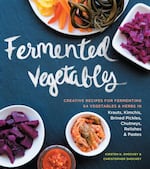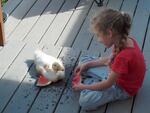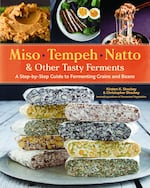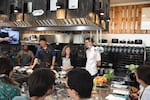Do you ever dream of moving to the country? You know, grow your own food in the garden, maybe raise a few chickens and goats.
Kirsten and Christopher Shockey moved to Southern Oregon's Applegate Valley to do just that: they wanted a humble homesteader life. And along the way, they became pioneers in a global fermented foods movement, with their newest book, "Miso, Tempeh, Natto & Other Tasty Ferments: A Step-by-Step Guide to Fermenting Grains and Beans," due out June 25.
Like other homesteaders, the Shockeys’ day generally begins with a trip to their garden, where every morning seems to deliver a delicious surprise.
“Oh my gosh, so good,” says Kirsten, popping a radish seed pod in her mouth and handing several to Christopher.
“They’re super peppery,” he replies after trying one. And then another. And then another. “I’m going to have to stop eating them.”
“Yeah, you are,” she laughs.

Kirsten and Christopher Shockey ferment basil, along with everything else they can grow, in the test kitchen in their home in Southern Oregon's Applegate Valley.
Kristen Henderson / OPB
While others might only harvest what they can eat while it’s fresh, the Shockeys have another goal in mind: fermentation. They pick the pods and a basket full of basil and head back to the commercial kitchen on the ground floor of their house. Setting their haul on the table, they break out bowls and salt. Because fermentation always begins with salt.
“Give me a nice sprinkle,” says Christopher, as Kirsten pours a quarter cup or so of salt on the basil and he starts to rub it in. “So this is the magic. We’re going to take a whole bowl of basil and massage that salt in. It’s pretty amazing: out of basil you can get that much brine coming out of there,” he says, squeezing a handful of leaves and watching the green brine run through his fingers.
They pack the basil and brine into a jar and put it in the pantry, where it joins shelves and shelves of colorful, bubbling brews. Fennel, leeks, rhubarb, rutabaga. Chances are if it grows in a garden, they’ve tried to ferment it.

The Shockeys first book has now sold over 100,000 copies and been translated into multiple languages.
Courtesy of Storey Publishing
But what, exactly, is fermentation?
It’s an ancient form of pickling, where instead of adding vinegar, you get the microbes that naturally occur on the veggies to do the preservation work for you. This is how Christopher explains it in classes for kids: “we’re going to use microbes — little, teeny, tiny guys; guys that you can’t even see — and their job is to eat the sugars, and they’re going to make lactic acid, which is that sour taste that you taste, and they’re going to fart CO2. And then usually the kids are like, ‘Oh, my God, is it going be smelly?’ It’s like, ‘Yeah, it’s microbe farts!’”
It might be smelly, but as the Shockeys like to point out, it’s also good for you. Scientists are finding that the microbes themselves, called probiotics, are beneficial, and as they break down the food, they add extra vitamins. And, unlike freezing or drying, fermenting preserves the volatile oils that hold in flavor.
“So it’s like you’re taking the smell on this harvest of right now,” says Kirsten as she points to the basil, “and you’re going to capture it in that jar.”
The Shockeys didn’t set out to be mad culinary scientists. They originally moved from Corvallis to Oregon's Applegate Valley in 1998 in search of a simpler life.

The Shockeys moved to the Applegate Valley in large part to connect their children with the land and where their food comes from — although who's feeding who is open to question.
Courtesy of Christopher and Kirsten Shockey
“Especially as the kids were starting to grow, I just wanted them to be grounded,” Kirsten says. “I wanted them to have a connection with the land, and I wanted them, more than anything, to know where their food came from.”
The idea was to get their 40-acre homestead to pay for itself, which turned out easier said than done. Their first thought was a vineyard, but everyone else was doing it. Then they decided to make cider, but it was going to take years for the apple trees to mature. So they tried a dairy, but they couldn’t grow enough fodder to make it sustainable.
Meanwhile, they got a crock of sauerkraut as a gift and that inspired them to start making it at home. It turned out to be a crock of kraut that changed their lives.
“Then we thought we should launch our own label,” Christopher says. “We schlepped a lot of sauerkraut to farmer’s markets back in the day when it wasn’t sexy — a lot of yucky faces.”
At the time, most Americans associated sauerkraut with the canned goop served at ballgames. But like the pioneers who came to the Applegate Valley before them, the Shockeys were resourceful. They saw fermentation as a way to bottle the beauty and the bounty of the landscape around them — and customers began to flock to their flavorful concoctions.

With their newest book, the Shockeys are particularly excited about introducing readers to the smelly but incredibly healthy natto, a form of fermented soy that hasn't yet caught on in the US.
Courtesy of Storey Publishing
“We created vegetable recipes that maybe didn’t have a cabbage blade in them at all, and so the idea was really working locally,” Kirsten says.
“She did 52 varieties in one year: 52,” Christopher exclaims.
They experimented with fermenting anything and everything neighboring farms grew in surplus, creating a tool for local farmers to transform a loss into a profit.
“It’s using what would be considered waste products a lot of times, whether they’re, as my husband puts it, ‘cosmetically challenged vegetables,’ or overruns,” says Mary Alionis, owner of the nearby Whistling Duck Farm and Store and a longtime Shockey supplier. “So it also allows me to grow a surplus of things, and then I know that I’m not going to have too much because my surplus can go into fermentation.”
Realizing there was only so much kraut one couple could sling — and in response to repeated customer requests for recipes — Christopher suggested they write a cookbook (and eventually turn the production business over to Alionis). Kirsten’s response: it’s been done.
“The only fermentation book out there at the time was Sandor Katz’s ‘Wild Fermentation,’ so a small one and Christopher plucked it off the shelf and came back to me and said, ‘Yeah, but there’s only 17 pages of vegetables.’
So they started going through vegetables alphabetically, arugula to zucchini, in a quest to figure out how to ferment them all. In 2014, they published the results in a cookbook titled “Fermented Vegetables: Creative Recipes for Fermenting 64 Vegetables & Herbs in Krauts, Kimchis, Brined Pickles, Chutneys, Relishes & Pastes.” The book has now sold more than 100,000 copies worldwide and helped feed the fermentation wave that swept things like kimchi, kombucha, and kiefer into the mass culinary consciousness — and every grocery store near you.
“There’s a revitalization of sauerkraut in Germany, for example, and that’s with books like ours,” Christopher says. “And so to think that two people from Oregon are responsible in some little way for Germans to learn how to make sauerkraut … it’s just mind-blowingly cool!”

The Shockeys travel the world teaching fermentation workshops, including this one in Santiago, Chile.
Courtesy of Christopher and Kirsten Shockey
The Shockey's have followed with a condiment cookbook, "Fiery Ferments;" their upcoming guide to fermenting miso, tempeh, natto and other legumes; and a new book about cider that's in the works. Now they travel the world to teach their Oregon-grown gospel of fermentation.
The Shockeys may come up with recipes, but what they really hope people take away from their books and classes is a playful willingness to experiment with fermentation.
“What I’ve seen is this explosion of creativity,” Kirsten says. “People all over the country and all over the world saying, ‘Wow, look, I can use this method, this thing that has worked, you know, since people had a vessel and some salt, really — and look what I can do with it. Look at the flavors that can happen!”
